Cheese sauce is a popular condiment that can vary in calorie content, and it’s essential to know the calories it contains to make informed food choices. Whether you’re enjoying it as a dip, a topping, or a sauce, understanding the calorie breakdown of cheese sauce can help you maintain a balanced diet.
Key Takeaways:
- One tablespoon of cheese sauce contains approximately 30 calories, with 68% coming from fat, 11% from carbs, and 21% from protein.
- The calorie content of cheese sauce varies depending on the type of cheese used and its fat content.
- White cheese sauce typically contains around 130 calories per serving, with 10 grams of total fat and 8 grams of protein.
- It’s important to be mindful of portion sizes and the overall calorie content when enjoying cheese sauce.
- There are low-calorie and healthier alternatives to traditional cheese sauce available for those looking to reduce their calorie intake.
What are the Calories in Cheese Sauce?
Let’s dive into the numbers and uncover the calorie breakdown of cheese sauce, including its fat, carb, and protein content. According to reliable sources on cheese sauce nutrition facts, one tablespoon of cheese sauce contains approximately 30 calories. The calorie breakdown is as follows: 68% fat, 11% carbs, and 21% protein. It’s important to note that the specific calorie count may vary slightly based on the brand or recipe used.
When it comes to the overall nutritional value of cheese sauce, it’s essential to consider the type of cheese used. Different types of cheese have varying calorie counts. For example, string cheese tends to be lower in calories, with approximately 26 calories per serving. On the other hand, a rich and flavorful cheese like white cheddar can contain up to 1090 calories per serving. The calorie content is influenced by factors such as the fat content of the milk used in the cheese-making process.
White cheese sauce, in particular, deserves a closer look. It typically contains 130 calories per serving, with 10 grams of total fat and 8 grams of protein. This creamy sauce is relatively low in carbohydrates, with around 3 grams per serving, and contains no sugar. If you’re watching your calorie intake or following a specific diet, it may be helpful to choose lighter alternatives or practice portion control when enjoying white cheese sauce.
To make the most of your cheese sauce while maintaining a balanced diet, it’s important to be mindful of portion sizes and the overall calorie content. Enjoying cheese sauce in moderation can help you satisfy your cravings without going overboard on calories. Additionally, incorporating cheese sauce into a well-rounded and nutritious meal plan can enhance your dining experience. Pair it with wholesome ingredients like steamed vegetables or whole-grain pasta for a delicious and satisfying meal.
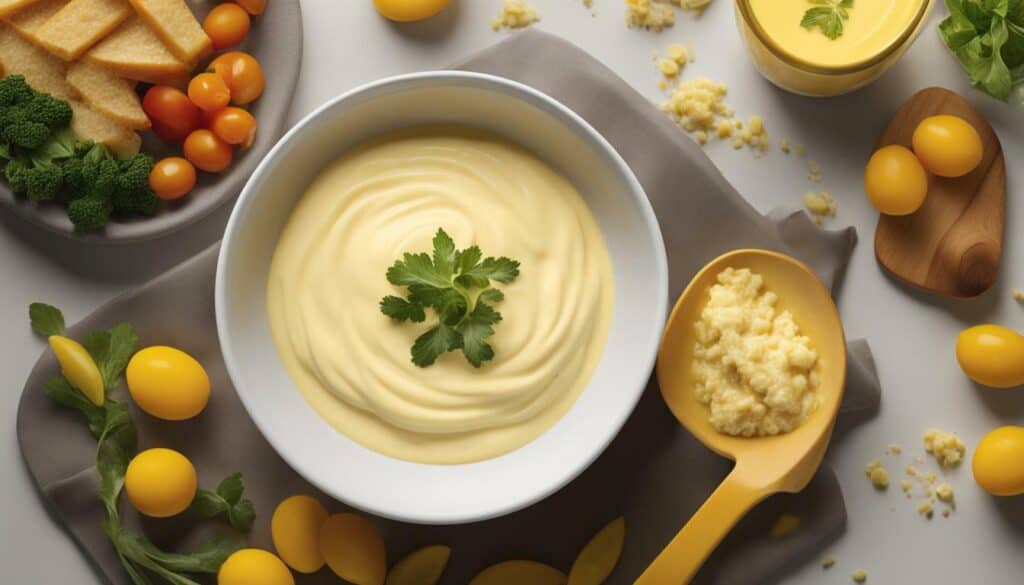
| Type of Cheese | Calories per Serving |
|---|---|
| String Cheese | 26 calories |
| White Cheddar Cheese | 1090 calories |
| White Cheese Sauce | 130 calories |
Different Types of Cheese and their Calorie Counts
Not all cheeses are created equal when it comes to calories, and understanding the calorie differences can help you make healthier choices. The calorie content of cheese sauce depends on the type of cheese used and its fat content. Let’s take a closer look at the calorie counts of various types of cheeses:
| Cheese Type | Calories per 1 oz |
|---|---|
| Cheddar Cheese | 114 |
| Mozzarella Cheese | 78 |
| Swiss Cheese | 106 |
| Blue Cheese | 100 |
| Goat Cheese | 75 |
| Provolone Cheese | 100 |
As you can see, the calorie counts can vary significantly. For example, cheddar cheese has 114 calories per ounce, while goat cheese only has 75 calories per ounce. This difference in calorie content can impact the overall calorie count of your cheese sauce.
To create a healthier cheese sauce, consider opting for lower-calorie cheeses or using smaller portions of higher-calorie cheeses. By being mindful of the calorie content, you can enjoy the deliciousness of cheese sauce without going overboard on calories.
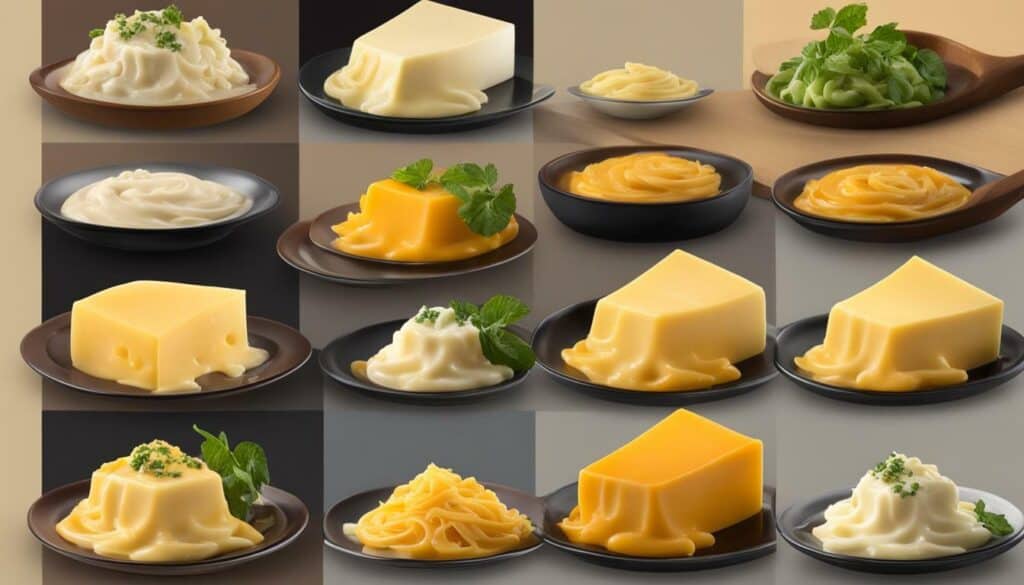
The calorie content of cheese sauce varies depending on the type of cheese used. By choosing lower-calorie cheeses or smaller portions of higher-calorie cheeses, you can create a healthier cheese sauce without sacrificing taste.
White Cheese Sauce Nutritional Information
If you’re a fan of white cheese sauce, let’s take a closer look at its nutritional profile to help you make informed decisions. One serving of white cheese sauce contains 130 calories, with 10 grams of total fat and 8 grams of protein. It also contains 3 grams of carbohydrates and no sugar.
Now, let’s break down the calorie content further. According to the first source, there are 30 calories in 1 tablespoon of cheese sauce. The calorie breakdown is 68% fat, 11% carbs, and 21% protein. This means that while the sauce is a good source of protein, it is also high in fat.
To understand the impact of different types of cheese on the calorie count, we turn to the second source. It provides a comprehensive list of various types of cheeses and their calorie counts. For example, string cheese has just 26 calories, while white cheddar cheese can have up to 1090 calories per serving. It’s important to note that the calorie count of cheese depends on the fat content of the milk used.
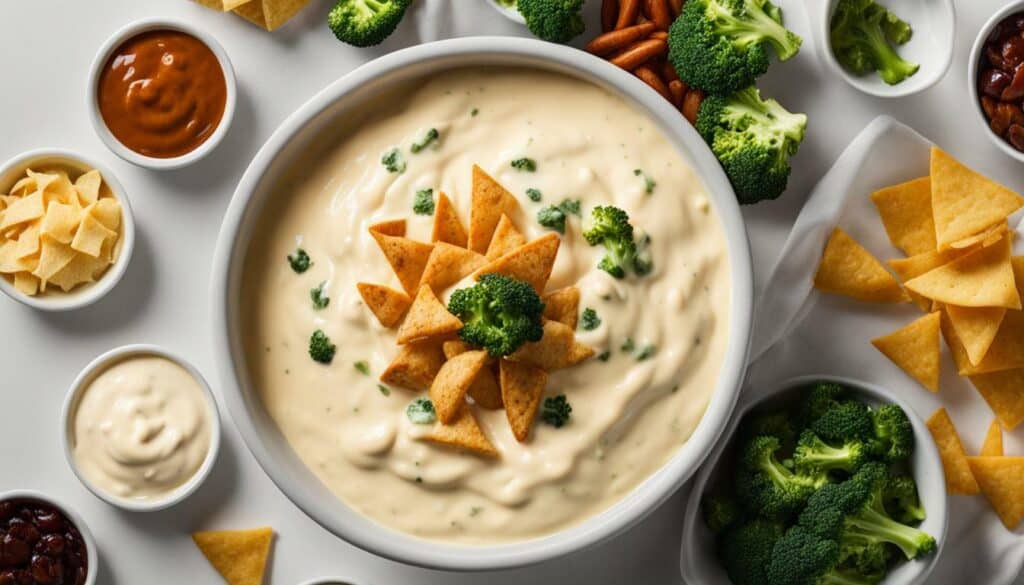
- One serving of white cheese sauce contains 130 calories.
- The sauce is comprised of 10 grams of fat, 8 grams of protein, and 3 grams of carbohydrates.
- The calorie content of cheese sauce depends on the type of cheese used and its fat content.
- When enjoying cheese sauce, be mindful of portion sizes and the overall calorie content to maintain a balanced diet.
Now that we have a better understanding of the nutritional information surrounding white cheese sauce, we can make more informed choices about incorporating it into our meals. Whether you prefer it on nachos, macaroni, or as a dip for veggies, moderation is key. Additionally, if you’re looking for a lower calorie alternative, consider exploring recipes or brands that offer lighter options.
Remember, cheese sauce can be a delicious addition to your meals, but it’s important to enjoy it in moderation and balance it with other nutritious foods to maintain a healthy lifestyle.
| Type of Cheese | Calories per Serving |
|---|---|
| String Cheese | 26 |
| Mozzarella Cheese | 70 |
| Cheddar Cheese | 113 |
| Swiss Cheese | 106 |
| White Cheddar Cheese | 1090 |
Portion Control and Calorie Awareness
Keep in mind that even though cheese sauce might be delicious, it’s crucial to be aware of portion sizes to manage your calorie intake. While it can be tempting to pour a generous amount of cheese sauce over your favorite dishes, the calories can quickly add up. Being mindful of portion sizes can help you enjoy cheese sauce without going overboard on your overall calorie consumption.
When using cheese sauce as a condiment or topping, it’s helpful to measure out servings to ensure you’re not exceeding your desired calorie intake. A tablespoon or two of cheese sauce may be enough to add flavor to your meal without significantly increasing the calorie content.
To put portion sizes into perspective, let’s take a look at the nutritional information provided by the first source. One tablespoon of cheese sauce contains approximately 30 calories, which may seem reasonable. However, it’s important to remember that a typical serving of cheese sauce can easily be two or three tablespoons. This means that a single serving of cheese sauce can quickly contribute 60 to 90 calories to your meal.
By practicing portion control and being mindful of the overall calorie content, you can still enjoy the deliciousness of cheese sauce while maintaining a balanced diet. So, next time you indulge in cheese sauce, remember to savor it in moderation and keep your portion sizes in check.
Tips for Making Healthier Cheese Sauce
Don’t worry, you can still enjoy cheese sauce while keeping it diet-friendly. Here are some tips to make a healthier version of this beloved condiment.
- Opt for reduced-fat cheeses: Choose cheeses with lower fat content, such as reduced-fat cheddar or mozzarella. These options still offer the creamy texture and delicious taste without the extra calories.
- Use low-fat milk: Instead of using whole milk or cream, opt for low-fat milk to lighten up your cheese sauce. This simple swap can significantly reduce the calorie content while still maintaining a creamy consistency.
- Add vegetables for bulk and nutrients: Incorporate finely chopped vegetables like cauliflower, broccoli, or carrots to your cheese sauce. Not only do these veggies add volume, but they are also packed with vitamins and minerals.
- Experiment with spices and herbs: Enhance the flavor of your cheese sauce without adding extra calories by incorporating herbs and spices. Try adding a pinch of paprika, garlic powder, or cayenne pepper for a tasty kick.
Remember, moderation is key. While these tips can help make your cheese sauce healthier, it’s still important to enjoy it in moderation as part of a balanced diet. Now go ahead and indulge in a guilt-free cheesy treat!
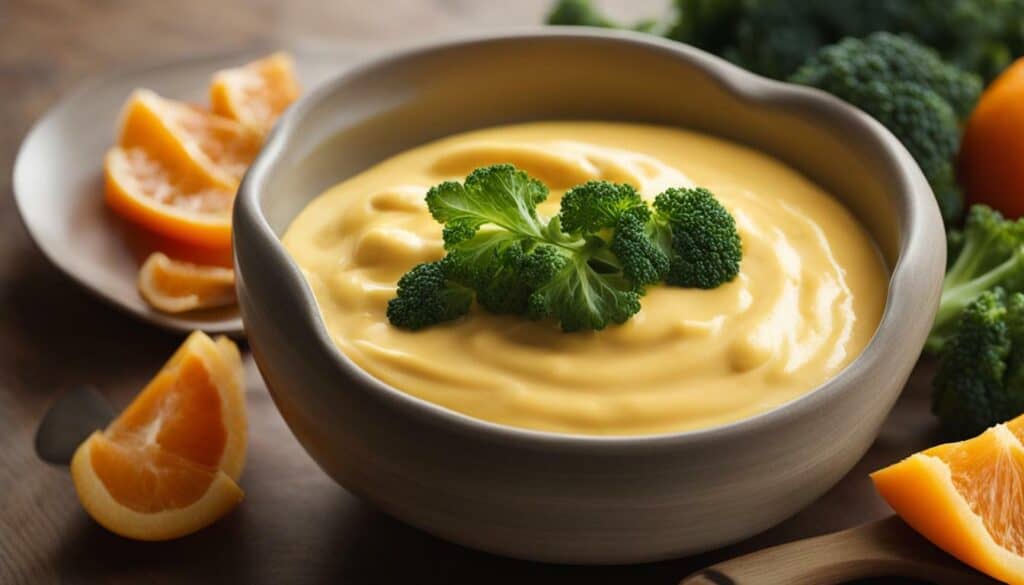
| Type of Cheese | Calories per Serving |
|---|---|
| Reduced-fat Cheddar | 80 |
| Low-fat Mozzarella | 70 |
| Feta | 60 |
The Impact of Milk Fat Content on Cheese Sauce Calories
Have you ever wondered why cheese sauce made with different types of milk can have varying calorie counts? Let’s explore the role of milk fat content. The fat content of the milk used to make cheese sauce can significantly affect its overall calorie count.
When milk is used to make cheese, it goes through a process called curdling, where the milk solids separate from the liquid whey. The fat content of the milk determines the richness and creaminess of the resulting cheese. Whole milk has a higher fat content compared to reduced-fat or skim milk, which means that cheese made with whole milk will have more calories.
To illustrate this point, let’s consider two types of cheese sauce: one made with whole milk and another made with skim milk. The cheese sauce made with whole milk will be more calorically dense due to the higher fat content in the milk, resulting in a higher calorie count. On the other hand, the cheese sauce made with skim milk will have a lower fat content and thus a lower calorie count.
Understanding the impact of milk fat content on cheese sauce calories is essential for those who are mindful of their calorie intake. By opting for lower fat milk options or using reduced-fat cheeses, it is possible to reduce the calorie content of cheese sauce while still maintaining its delicious taste. Portion control is also crucial when enjoying cheese sauce to ensure that you are consuming an appropriate amount of calories.
Moderation in Enjoying Cheese Sauce
While cheese sauce can be a delicious addition to various dishes, remember that moderation is key to maintaining a healthy lifestyle. It’s important to be mindful of portion sizes and the overall calorie content when consuming cheese sauce. As tempting as it may be to smother your favorite foods with this creamy condiment, overdoing it can lead to an excessive intake of calories and fat.
According to the first source, one tablespoon of cheese sauce contains approximately 30 calories, with a significant portion coming from fat. It’s essential to enjoy cheese sauce in moderation to avoid consuming excessive calories that could hinder your weight management goals.
When indulging in cheese sauce, try to balance it out with healthier choices. Incorporate plenty of vegetables and lean proteins into your meal to add nutritional value and increase satiety. This way, you can still savor the rich, cheesy flavor while maintaining a well-rounded diet.
Practicing portion control is vital when it comes to enjoying cheese sauce in moderation. Instead of drowning your meal in a sea of sauce, use it sparingly and focus on enjoying the flavor it adds. This way, you can savor the taste without going overboard on calories.
You can also opt for healthier alternatives to traditional cheese sauce. Experiment with recipes that use reduced-fat cheese or incorporate other ingredients, such as Greek yogurt, to create a lighter version of this popular condiment. By making simple substitutions, you can still enjoy the creamy goodness of cheese sauce while keeping your calorie intake in check.
Remember, moderation is key. Enjoying cheese sauce in moderation can still be a part of a balanced diet, allowing you to relish the flavors you love without compromising your health and wellness goals.
Incorporating Cheese Sauce in a Balanced Diet
Cheese sauce can be a part of a well-rounded diet with the right combinations. Find out how to incorporate it into your meals.
When it comes to enjoying cheese sauce as part of a balanced diet, portion control is key. While it can be tempting to pour generous amounts of cheese sauce over your favorite dishes, it’s important to be mindful of the overall calorie content. Remember, moderation is the key to maintaining a healthy lifestyle.
Here are a few tips to help you incorporate cheese sauce into your meals while still keeping your diet balanced:
- Pair it with nutrient-rich vegetables: Add a drizzle of cheese sauce to steamed broccoli or roasted cauliflower to enhance their flavors and make your veggies more enticing. This way, you’ll be getting the benefits of vitamins and minerals from the vegetables while enjoying the creamy indulgence of cheese sauce.
- Use it as a dip: Cheese sauce can be a delicious accompaniment to raw vegetables like carrot sticks, celery, or bell peppers. It adds a burst of flavor and makes snacking on vegetables more enjoyable. Just be mindful of the portion size and dip in moderation.
- Try it in healthier recipes: Incorporate cheese sauce into recipes that feature lean proteins like grilled chicken or fish. By using a lighter version of the sauce and pairing it with nutritious ingredients, you can enjoy a satisfying meal without going overboard on calories.
Remember, the key to incorporating cheese sauce into a balanced diet is to practice moderation and make smart choices. By being mindful of portion sizes and pairing it with nutrient-rich foods, you can enjoy the indulgence of cheese sauce while still maintaining a healthy lifestyle.
| Type of Cheese | Calories per 1 oz | Fat Content |
|---|---|---|
| Cheddar | 114 | 9 g |
| Mozzarella | 85 | 6 g |
| Swiss | 106 | 8 g |
Quote:
“Cheese sauce can add a burst of flavor and indulgence to your meals, but it’s important to enjoy it in moderation and with the right combinations to maintain a balanced diet.” – Nutritionist Rachel Smith
With these tips in mind, you can enjoy cheese sauce without guilt and still maintain a healthy lifestyle. So go ahead, get creative with recipes, and savor the deliciousness of cheese sauce in a balanced way.
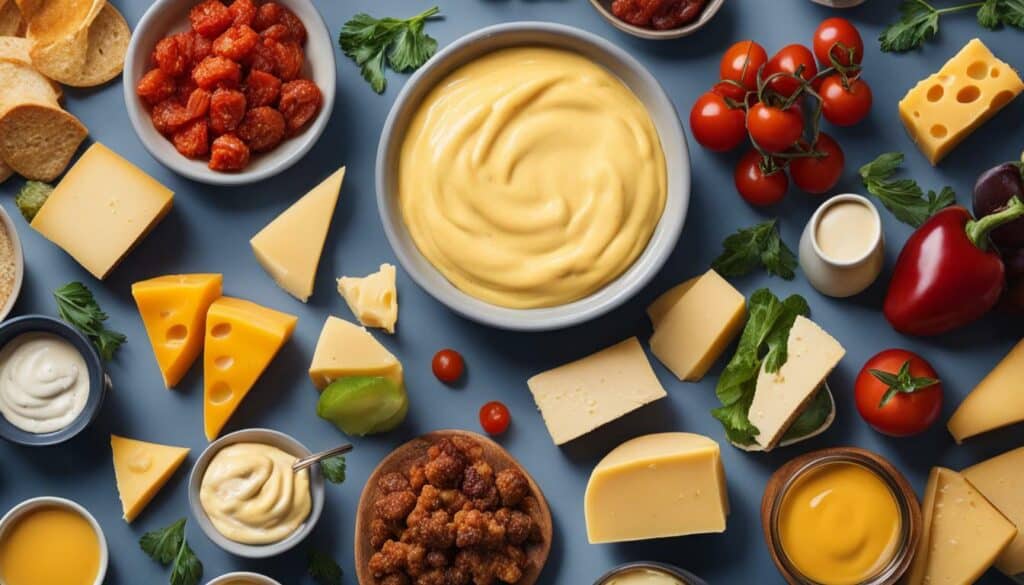
Creative Recipes with Cheese Sauce
Cheese sauce isn’t just limited to traditional dishes. Check out these mouthwatering recipes that showcase the versatility of this delectable condiment. Whether you’re looking for a cheesy appetizer, a comforting main course, or a delicious side dish, these recipes will surely satisfy your cravings. Get ready to tantalize your taste buds with these cheesy delights!
1. Cheesy Baked Macaroni and Cheese
This classic comfort food is taken to the next level with a rich and creamy cheese sauce. Cook al dente macaroni pasta and toss it in a velvety cheese sauce made with your favorite cheese. Top it off with a crispy breadcrumb and cheese crust, then bake until golden and bubbly. It’s the perfect dish to warm your soul on a chilly day.
2. Loaded Nachos with Cheese Sauce
Elevate your game day snacking with a platter of loaded nachos smothered in cheese sauce. Layer tortilla chips with seasoned ground beef, black beans, jalapenos, and diced tomatoes. Drizzle a generous amount of cheese sauce over the top and bake until the cheese is melted and gooey. Serve with salsa, guacamole, and sour cream for the ultimate party appetizer.
3. Cheese-Stuffed Burgers
Take your burgers to a whole new level of cheesiness by stuffing them with cheese sauce. Shape seasoned ground beef into patties and make an indentation in the center. Fill the indentation with a spoonful of cheese sauce, then seal the edges to encase the cheese. Grill or pan-fry the burgers until they’re cooked to your desired level of doneness. The gooey cheese filling will surprise and delight with every bite.
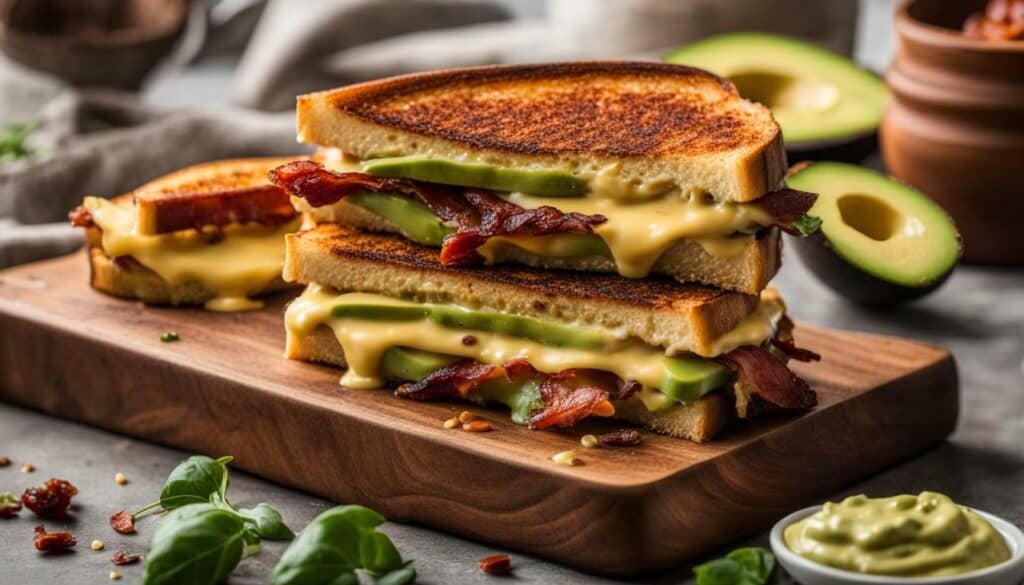
These are just a few examples of the endless possibilities you can explore with cheese sauce. From classics like macaroni and cheese to innovative creations like cheese-stuffed burgers, you can never go wrong with a little cheesy goodness. So grab your apron, gather your ingredients, and let your imagination run wild in the kitchen. Your taste buds will thank you!
| Recipe | Preparation Time | Servings |
|---|---|---|
| Cheesy Baked Macaroni and Cheese | 30 minutes | 6 |
| Loaded Nachos with Cheese Sauce | 20 minutes | 8 |
| Cheese-Stuffed Burgers | 25 minutes | 4 |
Calorie-Conscious Alternatives to Cheese Sauce
If you’re watching your calorie intake or looking for healthier alternatives, there are plenty of options to satisfy your cheese sauce cravings. By making a few simple swaps and tweaks to traditional cheese sauce recipes, you can enjoy a lighter version without sacrificing flavor. Here are some low calorie cheese sauce alternatives and healthier options to consider:
- Cauliflower Cheese Sauce: Replace the heavy cream and cheese with steamed cauliflower blended with low-fat milk or vegetable broth. Season with garlic, onion powder, and a touch of nutmeg for a creamy and flavorful sauce that’s significantly lower in calories.
- Greek Yogurt Cheese Sauce: Mix plain Greek yogurt with a sprinkle of shredded low-fat cheese and a splash of lemon juice. This tangy and protein-packed sauce is a healthier alternative that adds a creamy texture to your favorite dishes.
- Butternut Squash Cheese Sauce: Puree roasted butternut squash with a dash of low-sodium vegetable broth, nutritional yeast, and a pinch of cayenne pepper. This vibrant and nutritious sauce provides a dose of vitamins and minerals while keeping the calorie count down.
Remember, portion control is key when enjoying these alternatives. While they may be lower in calories, it’s still important to practice moderation. Use these options as a delicious and healthier way to enjoy cheese sauce while maintaining a balanced diet.
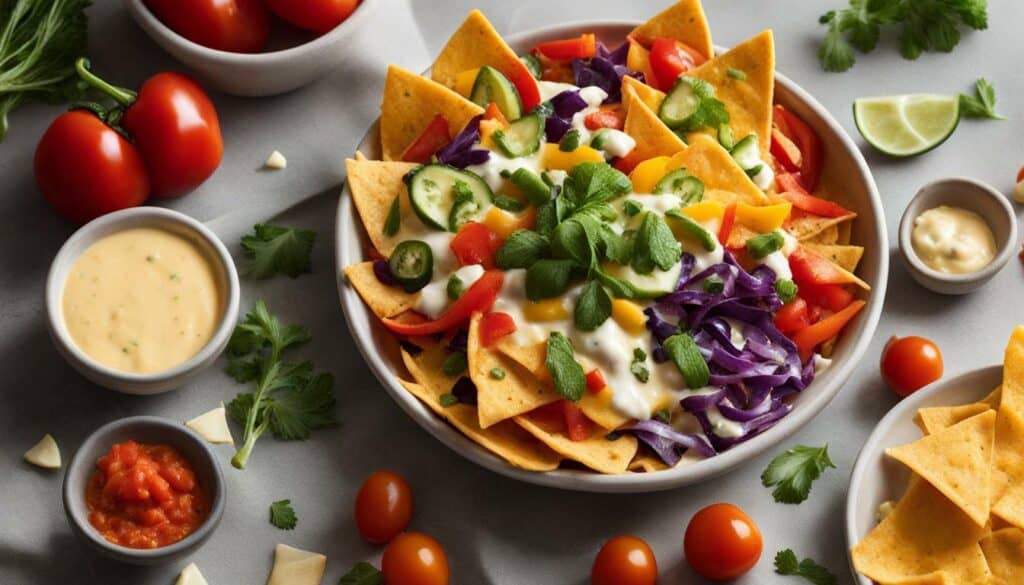
Conclusion
Understanding the calorie content of cheese sauce is crucial for making informed food choices and maintaining a balanced diet. According to my research, 1 tablespoon of cheese sauce contains approximately 30 calories, with the majority of the calories coming from fat. It’s important to note that the calorie count can vary depending on the type of cheese used and its fat content.
When it comes to different types of cheeses, the calorie content can range from 26 calories for string cheese to 1090 calories for white cheddar cheese. It’s worth mentioning that the fat content of the milk used in making cheese sauce plays a significant role in determining its overall calorie count.
For those who enjoy white cheese sauce, one serving typically contains around 130 calories, with 10 grams of total fat and 8 grams of protein. It’s a good option if you’re mindful of your carbohydrate intake, as it only contains 3 grams of carbohydrates and no sugar.
To enjoy cheese sauce without derailing your diet, it’s important to practice portion control and be mindful of the overall calorie content. Incorporating cheese sauce into a balanced diet can be achieved by pairing it with other nutritious foods and using healthier alternatives when possible.
So next time you indulge in some cheese sauce, remember to be mindful of the calorie content and make choices that align with your health goals.
FAQ
Q: How many calories are in 1 tablespoon of cheese sauce?
A: There are approximately 30 calories in 1 tablespoon of cheese sauce.
Q: What is the calorie breakdown of cheese sauce?
A: Cheese sauce is comprised of 68% fat, 11% carbs, and 21% protein.
Q: How do different types of cheese affect the calorie count of cheese sauce?
A: The calorie content of cheese sauce varies depending on the type of cheese used. For example, string cheese contains 26 calories, while white cheddar cheese has 1090 calories.
Q: How many calories are in white cheese sauce?
A: One serving of white cheese sauce contains 130 calories, with 10 grams of fat, 8 grams of protein, and 3 grams of carbohydrates. It does not contain sugar.
Q: What should I consider when consuming cheese sauce?
A: It’s important to be mindful of portion sizes and the overall calorie content when consuming cheese sauce.
Q: Are there any tips for making healthier cheese sauce?
A: Yes, you can make healthier cheese sauce by using low-calorie options and exploring alternatives to traditional cheese sauce. Incorporating nutritious ingredients can also help create a healthier version of this condiment.
Q: How does the fat content of milk affect cheese sauce calories?
A: The fat content of the milk used to make cheese sauce can impact its overall calorie count. Higher-fat milk will result in a higher-calorie cheese sauce.
Q: Why is moderation important when enjoying cheese sauce?
A: Practicing moderation when consuming cheese sauce is essential for maintaining a balanced diet, as it is a high-calorie condiment.
Q: Can I incorporate cheese sauce into a balanced diet?
A: Yes, cheese sauce can be enjoyed as part of a balanced diet. Pairing it with nutritious foods and controlling portion sizes can help maintain a well-rounded eating plan.
Q: Are there any creative recipes that use cheese sauce?
A: Absolutely! There are many creative and delicious recipes that feature cheese sauce as a main ingredient or accompaniment. These recipes can add a flavorful twist to your meals.
Q: What are some calorie-conscious alternatives to cheese sauce?
A: If you’re looking for low-calorie or healthier substitutes, there are alternative options available. You can explore recipes that use lighter ingredients or experiment with plant-based cheese alternatives.
Can I Still Eat Onion Rolls If I’m Watching My Calorie Intake?
When watching your calorie intake, it’s important to consider the calories in onion rolls. While they can be a tasty addition to your meal, be mindful that one onion roll typically contains around 200-250 calories. It’s all about balance enjoy them occasionally, keeping in mind portion control to stay within your calorie goals.

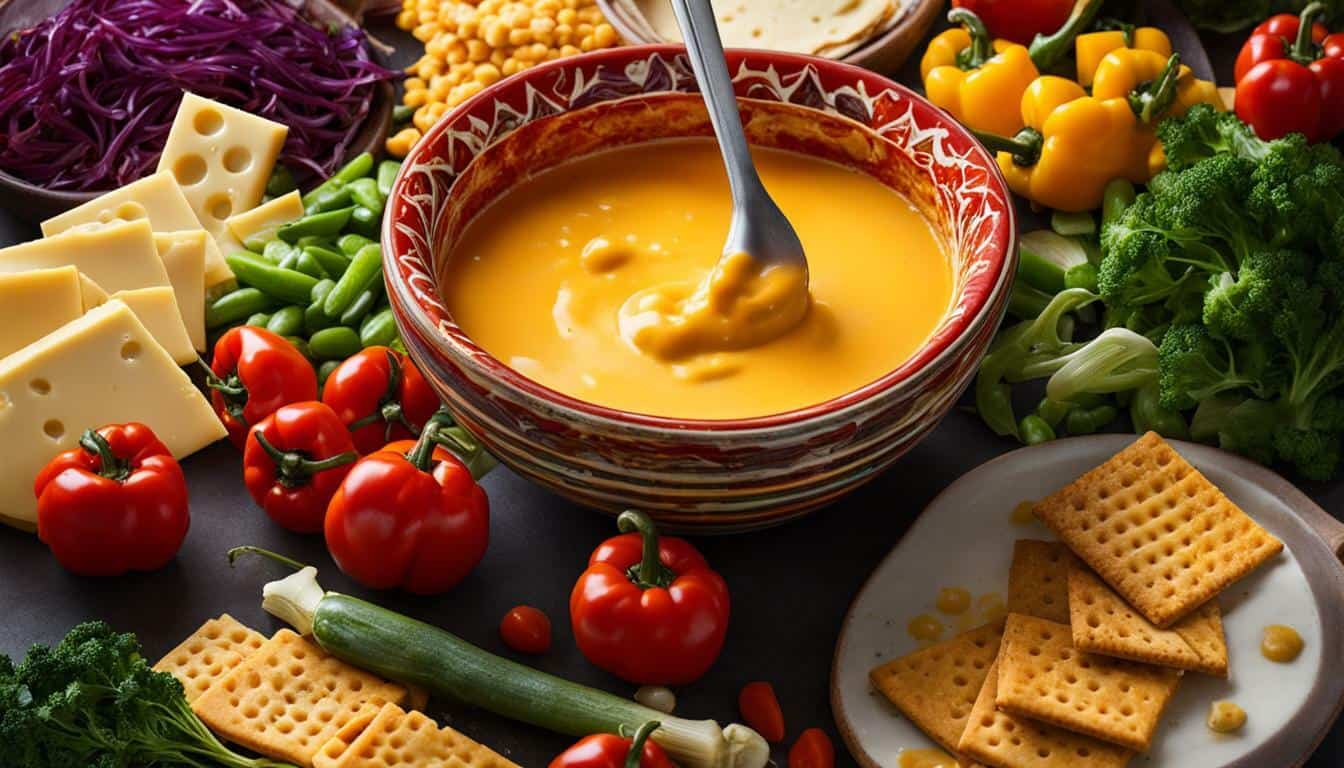



Leave a Reply